Growing up in Jamaica, Jacqueline Dwyer and Noel Livingston remember eating like kings and queens. The warm climate allowed them plenty of fresh, nutritious foods year-round; their plates always displayed a rainbow of colors.
“I was just a kid, and I took for granted the access to good and healthy food I had all the time,” explains Dwyer. “My grandmother and great grandmothers and other aunts and other older relatives created an oasis around us, a garden of Eden.”
When Dwyer was 14-years-old, her mother moved her family to Toronto, Canada, in search of better opportunities for her children.
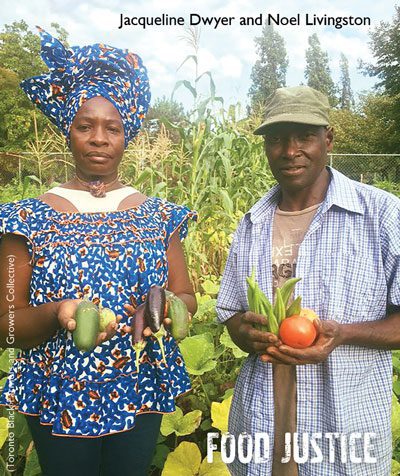
“I came here and lived in a country that actually goes through the seasons,” she says. “I learned about food poverty, food injustices, food insecurity, land ownership, and what that means, and how many people become really poor when they don’t have access to the land.”
Livingston, on the other hand, left Jamaica for Toronto as an adult. Tired of what he describes as racial oppression and classism in the British colony he grew up in, he was also looking for a better life in Canada. But he found the same systemic injustices were present in North America, only here, he says it’s called ‘polite racism.’
The city of Toronto currently has more than 30 communities flagged as Neighborhood Improvement Areas (NIAs). These are designated places that need help combating problems of poverty, crime, higher rates of diseases like diabetes, and a lack of access to services.
Many of the people living in these communities are minorities. In the neighborhood of Glenfield-Jane Heights, for example, nearly 60% of the population is immigrant. Over the years, Dwyer has watched a countless number of black business owners being pushed out of NIAs because they can’t afford rent, never mind nutritious food.
“It wasn’t a shock, but it (…) spurred me to look in another direction of sustainability for myself,” she says.
It Takes A Village
Today, Dwyer and Livingston take care of more than just themselves. Together, they founded a grassroots organization called the Toronto Black Farmers and Growers Collective, which aims to grow ‘clean’ food and get it into the hands and mouths of the people who can’t otherwise afford it. The collective is currently 30 members strong, with many of them coming to the farm throughout the week to help plant, maintain, and harvest the garden. In exchange for their time, the volunteers leave with a box of freshly-picked food for the week.
They grow foods culturally appropriate to their Caribbean and African roots; things like callaloo, okra, sweet potatoes, African spinach, cabbage, and more. People come to the urban farm to shop for tastes of home, something Livingston says helps them connect with the growers, and in the end, enjoy their food more.
“When people see exactly what we do, they appreciate the work,” he says. “They appreciate what they’re getting. They appreciate the farmer. They appreciate nature.”
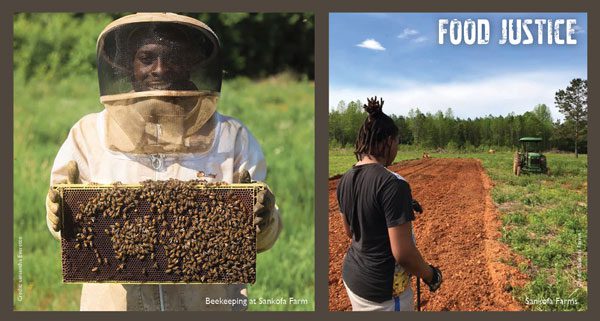
Beyond feeding the hungry and building the local food economy, the organization aims to educate the population on the importance of building relationships with the things we eat.
“We always tell people that [they] can do it,” Dwyer says. “It doesn’t matter if they’re on their balcony doing container gardening or in a small little plot in a community garden or on their own property.
“If you are willing to put your shoulders to the wheel and work, you can really live off the land sustainably.”
Uphill Battle
Growing with the seasons is undoubtedly challenging in Canada, and the collective receives no funding. Dwyer and Livingston run the farm with money from their own pockets, pointing to systemic racism as the culprit.
“We entered this arena very innocently, and we thought this would be a powerful outlet to activate justice for everyone to have access to good food,” Dwyer explains. “But we learned quickly in the game that it wasn’t so.”
She describes a culture in which money meant to help these communities falls into the wrong hands. Bigger organizations claim to be supporting the people, and yet citizens never reap the benefits.
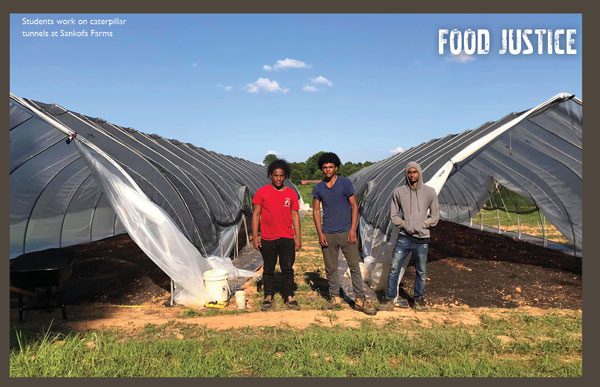
Still, they view sharing the little they have with people in need as a privilege. Livingston recalls delivering boxes of donated food, eggs, and toys to three NIAs last December.
“I’m a person, not very emotional, but it brought tears to my eyes when I saw, not just children, but adults; when the food came, to see the rush. My God, these people are proud people, used to land and their own homes, and are brought down to this level,” he says. “You could see the hurt in their eyes. Many of them don’t want to come out because of pride, but they have children to feed.”
Food Apartheid
The 2020 deaths of George Floyd, Breonna Taylor, Rayshard Brooks, and countless other black people at the hands of the police have sparked worldwide protests and further ignited the Black Lives Matter movement. Activists are trying to send a clear message: racial inequality exists all around us, even where land and food are concerned.
Food deserts are defined as areas in which affordable and nutritious food is difficult to find. It’s not that there isn’t any food to be found; there’s plenty of it in the form of fast-food chains. Meals found in food deserts are typically easy, cheap, and outrageously unhealthy.
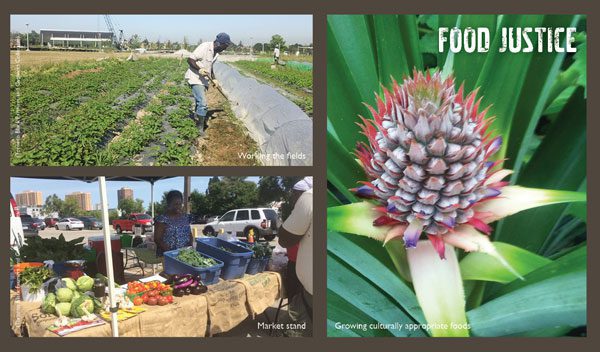
While all of this is undoubtedly true, the Food Empowerment Project says a few details are missing from the widely-used definition. Rather than being just about proximity to fresh food, the organization recognizes that food deserts have a lot to do with structural racism, the cost of living, the cultural appropriateness of available foods, and the people’s ability to grow their fruits and vegetables. Furthermore, multiple studies have found that food deserts are often located in black or brown communities.
Savi Horne, executive director of the Land Loss Prevention Project in North Carolina, also takes issue with the term “food desert.” She says it’s time to start calling it what it is: food apartheid.
“That’s shifting away from ‘food desert’ because that implies that you created the condition,” she explains. “When you say food apartheid, you’re looking a the structural racism and other structural issues, like racial capitalism that has led to a broken food system that’s impacting black folk’s health; poor folk’s health.”
A group of black lawyers formed the Land Loss Prevention Project (LLPP) in 1982 after seeing black farmers losing their land and going out of business at a higher rate than white ones. The LLPP provides legal support to limited-resource farmers and landowners in North Carolina and promotes environmental justice by helping people of color develop sustainable farming practices.
Horne recalls helping a rural farm family that lost a 180-acre property after being subjected to discrimination and unfair treatment by government agencies and programs.
“They were providing access to nutritious vegetables that were culturally appropriate to their African American community,” she says. “When they lost their farm, it was a personal loss to them, but it also had ripple effects within the community. It took years to get back to a place where they are now re-engaged, even experimenting with fish protein by growing tilapia.”
While the family in question is resilient and is farming again, unfortunately, nearly 40 years after the LLPP was formed, Horne says there has been little progress. The Black Lives Matter movement reminds us that a serious conversation needs to be had about a radical reordering of society.
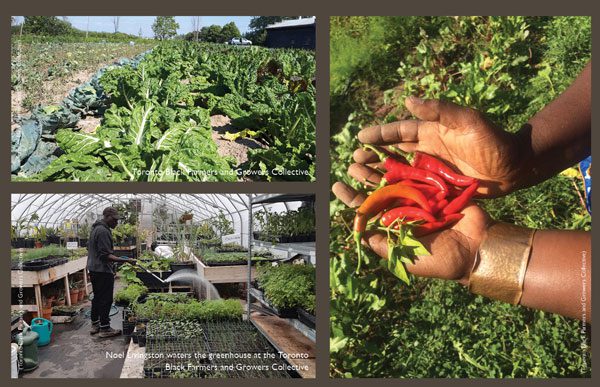
“We are still dealing with the vestiges of a racialized agriculture system, a social system with its racial atmosphere in which African Americans and low-income people are still dealing with a lack of access to quality education, quality healthcare, and affordable and nutritious food.”
Building the local food economy in minority communities is paramount, especially one that caters to specific cultural backgrounds and needs. Horne believes one of the best ways to do that is by providing young black farmers with the security of tenure on their land, which gives them government protection from evictions.
A Greater Calling
At Sankofa Farms, also in North Carolina, Kamal Bell believes that land ownership is critical to controlling one’s destiny. He wasn’t always planning on being a farmer, but while studying to become a veterinarian at the North Carolina Agricultural and State University in 2009, he realized he needed to answer a question that had been nagging him: how could he really help the African American community?
“When you go to black neighborhoods, primarily those with lower socioeconomic status, what you see is fast food restaurants everywhere,” he says. “It’s more of a culture thing because people are trying to live day to day; they’re not really thinking about long-term decisions and outcomes.
“If I got a farm, we could produce food and help curb the effects of food deserts.”
Bell changed his major from animal science to animal industry, which taught him about the production side of agriculture. Shortly after graduation, he took out a loan and bought 12 acres of land in the Durham region.
It has taken years of work, but finally, Bell has cleared enough of his property to start growing fresh food. He has even started an academy for the youth in the area, in which they learn how to grow collards, kale, chard, spinach, and lettuce, and help distribute it to the locals.
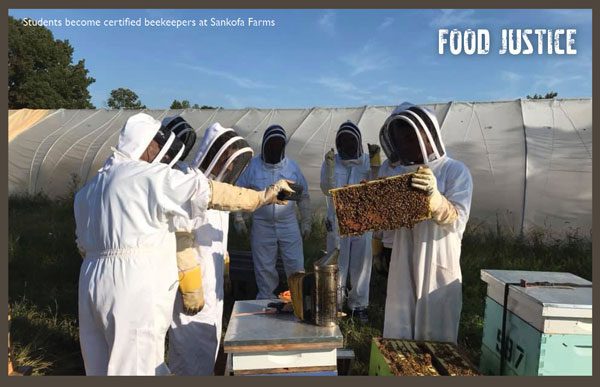
There are six students currently enrolled at the Sankofa Farms Agricultural Academy. Bell drives around Durham in an old ’94 minivan picking them up for their days at the farm, where they’re introduced to STEM learning concepts. Beyond farming and beekeeping, they’re also taught hard work, leadership, teamwork, and valuable life skills. Most of all, the program focuses on how black people can help each other and give the students a foundation so they can eventually succeed in other avenues.
At the age of 15, Mikal Ali has been a student at the academy for three years.
“Mr. Bell has taught us about really having ownership and getting away from the dependency mindset that a lot of kids learn to have in the school system, “Ali says. “The main thing Mr. Bell wants us to learn is ownership and helping our community thrive and grow.”
Ali hopes to buy a piece of land one day and build something for himself on it. He also dreams about a career in psychology; something he says the critical thinking skills learned on the farm will help him accomplish.
“On the farm, if you see something and ask him what it is, it’s not like he just tells us the answer so we can be dependent on him or someone else when we get older,” Ali says. “He makes us go and look at the problem and what we can do to solve it.”
There’s teaching on the farm, but Bell says there’s also a steep learning curve in many of the underprivileged communities.
“You just can’t go into a community and say, ‘Hey! Take this food; it’s fresh.’ You have to build relationships; you have to actually care. People have to understand that you are there to help them.”
He’s currently working on his doctorate for agricultural extension education so he can eventually open a full-time alternative school. It’s a lot of work, but he wouldn’t have it any other way.
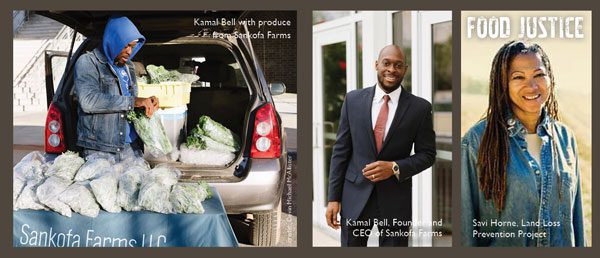
You can learn more about Sankofa Farms Agricultural Academy and donate to its efforts at sankofafarmsllc.com.
“Black people in these areas are suffering (…) I think as a duty and as my purpose in life, or our purpose, in general, is that you’re supposed to be helping people,” he says. “If you see a problem, you help people.”
Moving Forward
While individual efforts like Bell’s and other grassroots activists are very much needed, a radical change must also be encouraged from the top levels of government.
“You need leadership, and we don’t have leadership right now,” says the LLPP’s Horne. “We have a leadership that wants to further victimize and divide people from doing what they see needs to be done.”
Still, she says inspiring local food models are continuing to emerge from communities across North America, and that’s all part of the battle.
Back in Canada, the Toronto Black Farmers and Growers Collective is currently working on one it hopes to one day share all around the world. The organization is creating a food hub in partnership with the Country Heritage Park in Milton, Ontario, where crops are grown and distributed to the food insecure. The park provides the land and the collective provides the food.
“It’s a class structure that we see now,” says Livingston. “It doesn’t matter what color or ethnicity you are; it’s community.”
By becoming involved in local food production, we can move forward while nourishing our bodies, minds, and souls. Healthier people lead to healthier communities, making brighter futures a possibility.
“We need more people to speak out, we need more people to stand up, and we need people to come together equitably to share the resources so we can develop our own communal systems,” says Dwyer. “If people set their differences aside and decide they want to fix things, it can be done. We don’t need to create uproars; we don’t need to kill each other. We can be civil, and we can get it done.”
So let’s get to work, shall we? It’s time we all take a stand.